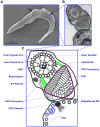The flagellum of Trypanosoma brucei: new tricks from an old dog
- PMID: 18472102
- PMCID: PMC3210513
- DOI: 10.1016/j.ijpara.2008.03.003
The flagellum of Trypanosoma brucei: new tricks from an old dog
Abstract
African trypanosomes, i.e. Trypanosoma brucei and related sub-species, are devastating human and animal pathogens that cause significant human mortality and limit sustained economic development in sub-Saharan Africa. T. brucei is a highly motile protozoan parasite and coordinated motility is central to both disease pathogenesis in the mammalian host and parasite development in the tsetse fly vector. Therefore, understanding unique aspects of the T. brucei flagellum may uncover novel targets for therapeutic intervention in African sleeping sickness. Moreover, studies of conserved features of the T. brucei flagellum are directly relevant to understanding fundamental aspects of flagellum and cilium function in other eukaryotes, making T. brucei an important model system. The T. brucei flagellum contains a canonical 9+2 axoneme, together with additional features that are unique to kinetoplastids and a few closely-related organisms. Until recently, much of our knowledge of the structure and function of the trypanosome flagellum was based on analogy and inference from other organisms. There has been an explosion in functional studies in T. brucei in recent years, revealing conserved as well as novel and unexpected structural and functional features of the flagellum. Most notably, the flagellum has been found to be an essential organelle, with critical roles in parasite motility, morphogenesis, cell division and immune evasion. This review highlights recent discoveries on the T. brucei flagellum.
Figures









References
-
- Adhiambo C, Forney JD, Asai DJ, LeBowitz JH. The two cytoplasmic dynein-2 isoforms in Leishmania mexicana perform separate functions. Mol Biochem Parasitol. 2005;143:216–225. - PubMed
-
- Badano JL, Mitsuma N, Beales PL, Katsanis N. The Ciliopathies: An Emerging Class of Human Genetic Disorders. Annu Rev Genomics Hum Genet. 2006;7:125–148. - PubMed
-
- Balber AE. The pellicle and the membrane of the flagellum, flagellar adhesion zone, and flagellar pocket: functionally discrete surface domains of the bloodstream form of African trypanosomes. Crit Rev Immunol. 1990;10:177–201. - PubMed
Publication types
MeSH terms
Substances
Grants and funding
LinkOut - more resources
Full Text Sources
Other Literature Sources

